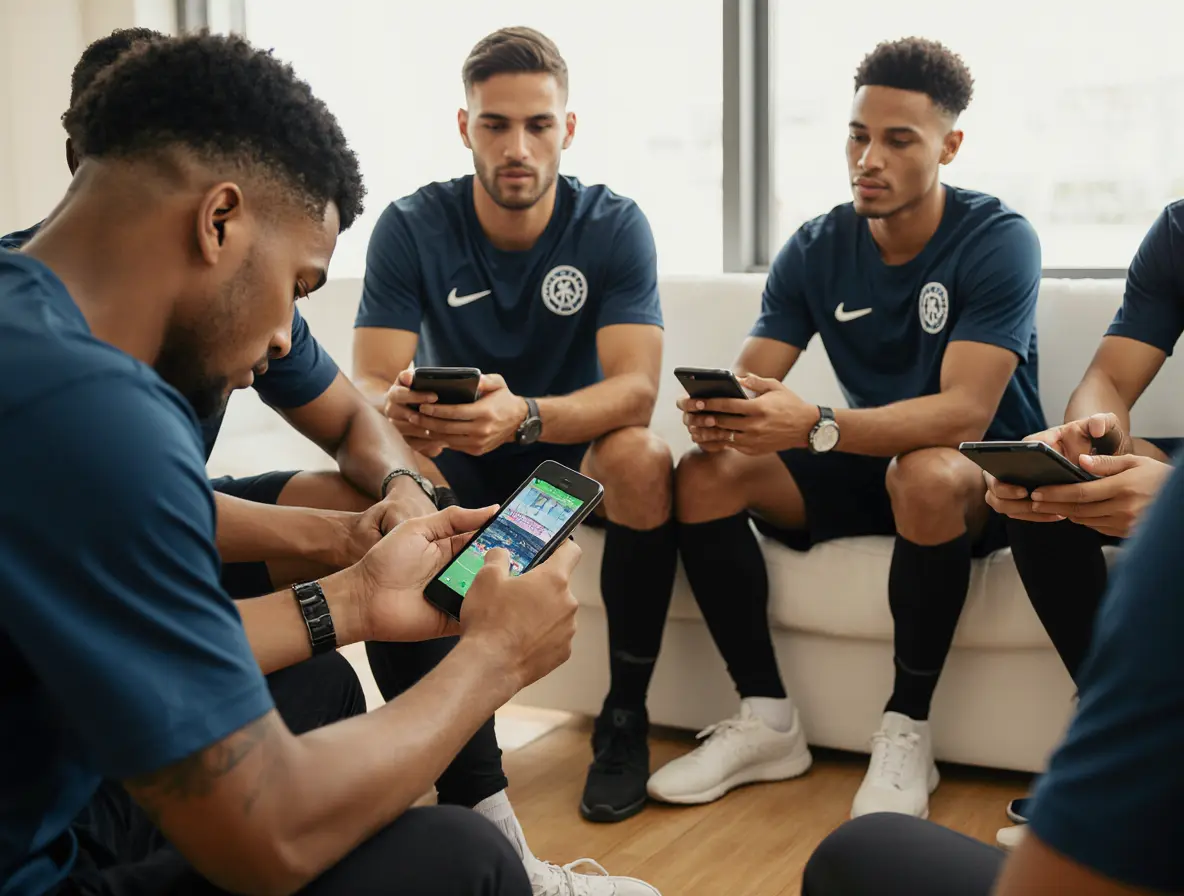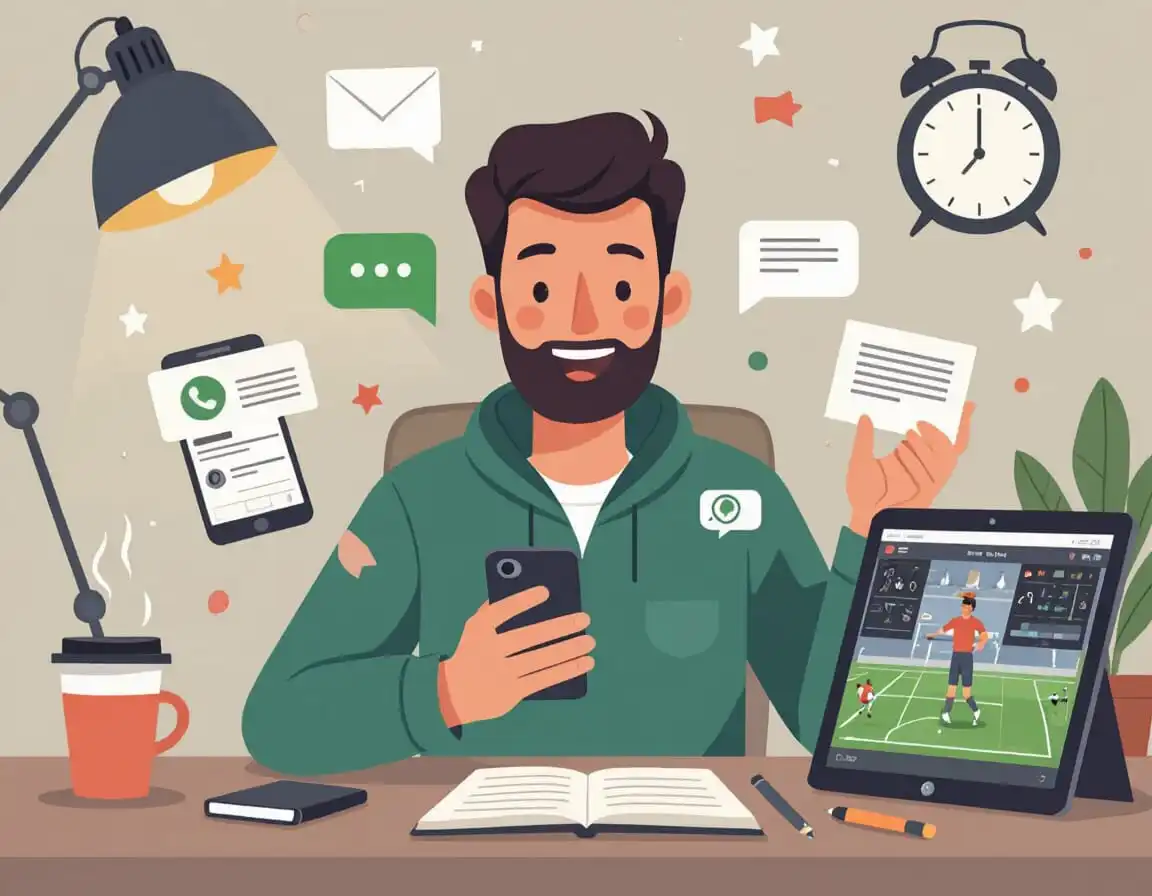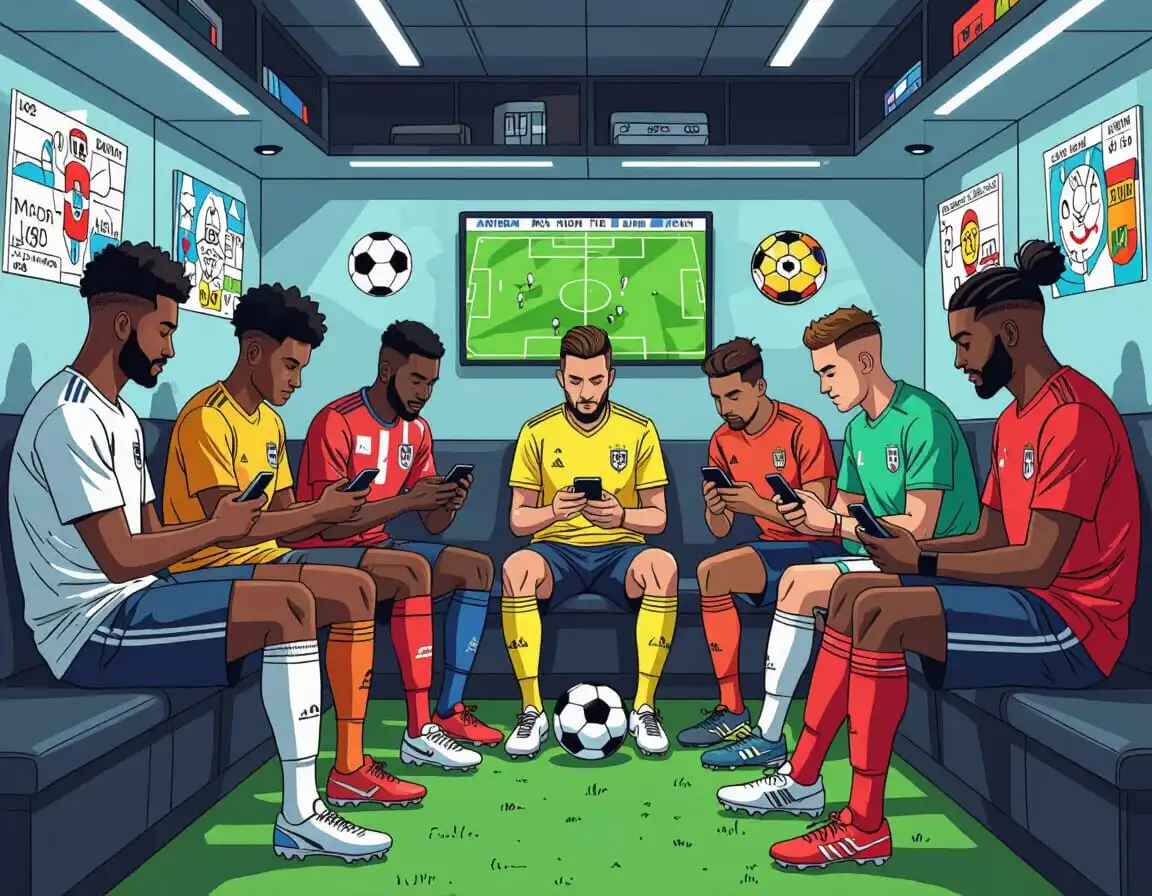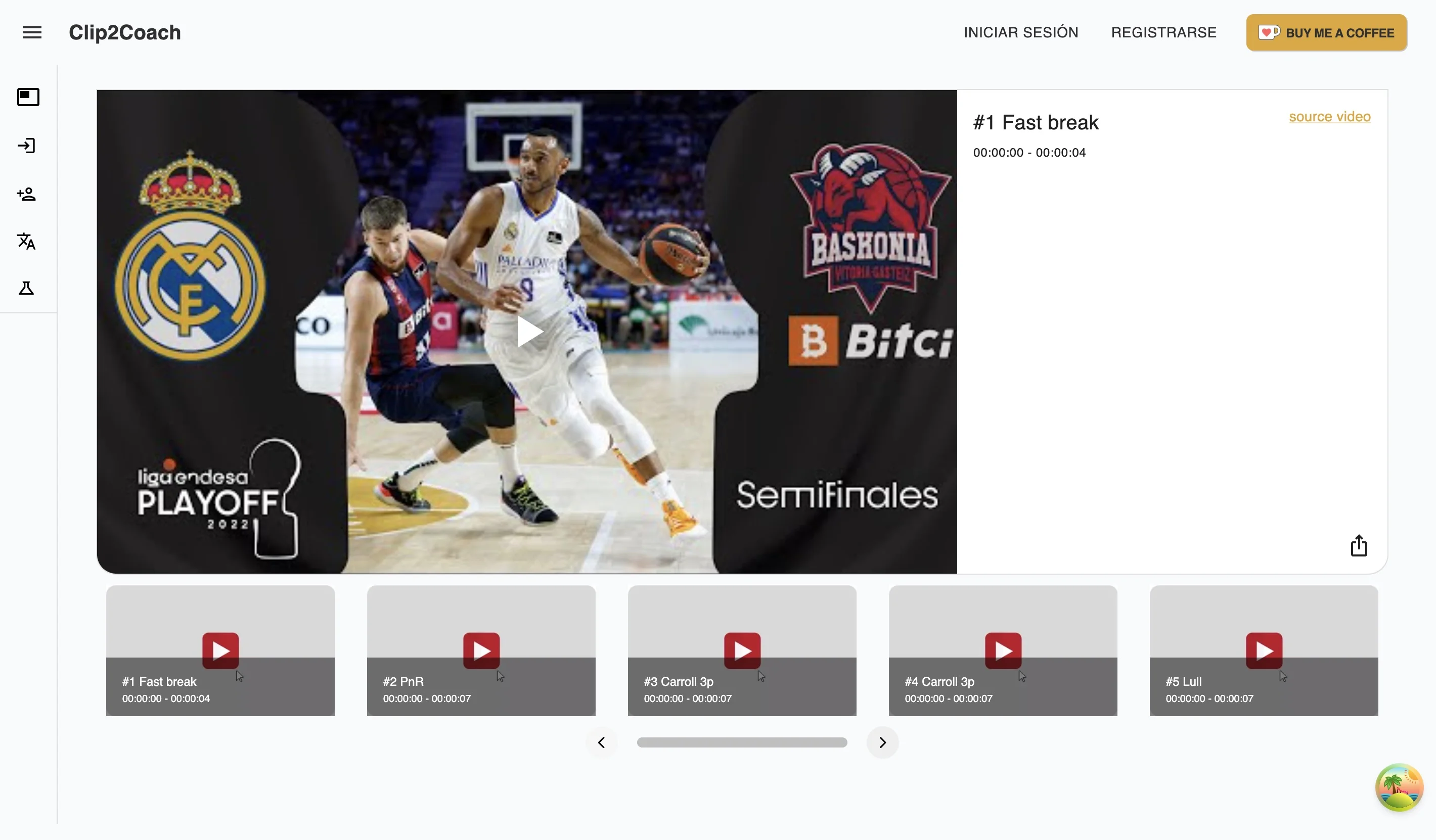
The WhatsApp Revolution: How to Communicate with Your Players Using Video
Remember the technical talks before training? Fifteen players in a semicircle, you with a whiteboard full of arrows and circles, explaining for the tenth time why it’s important to press as a block. By minute five, half were already thinking about other things. By minute ten, even you had gotten bored with your own explanation.
Now imagine this: you send a 45-second video to the team’s WhatsApp group. You show exactly how Liverpool executes that pressing you want to implement. Players watch it at home, on the bus, when they have time and desire. They arrive at training knowing exactly what they’re going to practice. The revolution isn’t in the technology, it’s in understanding how today’s players really communicate.
WhatsApp: The Virtual Locker Room
WhatsApp isn’t just a messaging app for your team. It’s the virtual locker room where important conversations brew, where team culture is forged, where players actually pay attention. Ignoring this reality is like continuing to send letters when everyone uses email.
Modern players, especially younger ones, process information completely differently than we used to. It’s not that they have less attention capacity; it’s that they’re accustomed to receiving information visually, immediately, and digestibly. Sport video analysis software allows you to speak their language.
When you send a tactical clip via WhatsApp, you’re not just sharing information. You’re creating a shared experience. Players comment, ask questions, debate among themselves. It generates a tactical conversation you’d never achieve in a traditional talk.
The Architecture of Modern Communication
Not all messages go to the same place. You need structure, organization, intention behind each communication. Think of your WhatsApp like a stadium: each group has its specific function.
The Main Group is your public address system. Here go important announcements, videos everyone should see, things that build team culture. A motivational video before the match, a clip celebrating a spectacular goal, analysis of the play that came out perfect in the last training.
Position-Specific Groups are your specific technical talks. Defenders need to understand things that forwards aren’t as interested in, and vice versa. Here you can be specific, technical, detailed. Show Virgil van Dijk coordinating the defensive line, or how Benzema moves between lines to receive. In basketball, you can teach your point guards how Luka Dončić reads defenses in pick-and-roll, or show your centers how Giannis protects the rim and gets out fast in transition.
Individual Chats are your most powerful tool. This is where you can really impact a player’s development. A personalized video showing exactly what they need to improve, or celebrating something they did especially well. It’s individual coaching at a distance.

The Art of Creating Real Engagement
Engagement isn’t an empty buzzword. It’s the difference between players who watch out of obligation and players who eagerly await your content. And it’s achieved by understanding a fundamental truth: players don’t want to be passive students, they want to be part of the conversation.
When you send a video, don’t send it with a “Look at this.” Ask them questions. “What do you see at second 15 that we could apply?” “How would our right-back solve this?” Turn each clip into a dialogue opportunity.
Modern sports analysis tools for coaches allow you to create interactive content. Strategic pauses, inserted questions, clips that require a response before continuing. It’s not just watching, it’s participating.
Measuring What Really Matters
Forget complicated metrics. In the real world of amateur coaching, engagement is measured very simply: do your players arrive at training already knowing the concept you’re going to work on? Do they ask more specific questions? Do they automatically apply things they’d seen in video?
There’s also the most obvious metric: how many actually watch the videos? WhatsApp tells you who has seen each message. If you send a clip about high pressing and only three out of eleven players have seen it, you have a communication problem, not a tactical one.
But there are more subtle signs that are equally important. When a player spontaneously shares a clip in the main group. When you reference a video from weeks ago and everyone knows what you’re talking about. When they start using the tactical vocabulary you’ve established through videos.
Building Culture Through Visual Stories
Each team has its identity, its way of understanding football, its particular culture. Videos don’t just teach tactics; they tell the story of who you are as a team.
A clip of Atalanta pressing like crazy can teach tactics, but also transmits values: intensity, collective work, never giving up. A video of Barcelona at their best doesn’t just show how to circulate the ball, but speaks of patience, intelligence, technical quality.
In basketball, showing the Warriors from their golden era doesn’t just teach spacing and three-point shooting, but speaks of collective play, constant movement, and trust in teammates. A clip of Popovich’s Spurs can transmit discipline, perfect execution, and individual sacrifice for the team’s good.
Sport video analysis software like Clip2Coach allows you to keep these references organized and tagged, creating a coherent library that constantly reinforces the values you want to instill.
Choose your references consciously. The teams you use as examples become part of your team’s identity. If you always show Real Madrid, you’re talking about winning mentality and individual moments. If you prefer Leicester champion clips, you speak of teamwork and overcoming adversity. If you choose Magic Johnson’s Lakers, you transmit spectacle, creativity, and charismatic leadership.
The Shared Tactical Language
One of the most powerful things about video analysis is that it creates a common vocabulary. When you say “we do the Liverpool movement,” everyone knows exactly what you’re talking about. When you mention “Atalanta’s pressing,” you no longer need to explain how it works.
But this language isn’t created alone. You must be consistent in terminology, repeat concepts, ensure everyone understands the references. Clip2Coach allows you to tag and organize your clips so it’s easy to maintain this consistency.
Developing Leaders Through Video
The captains and natural leaders of your team can become your most powerful allies in this process. Teach them to create content, allow them to share clips they consider important, give them voice in the team’s tactical communication.
When a player respected by teammates shares a video explaining why it’s important to press in a certain way, it has more impact than the same message coming from you. Not because your authority isn’t important, but because peer validation is especially powerful.

Managing Generational Differences
In your team coexist players of different ages and different relationships with technology. The 35-year-old veteran who prefers traditional talks and the 19-year-old kid who lives glued to his phone need different approaches.
The key isn’t forcing everyone toward the same model, but using multiple channels. Video serves as perfect complement to traditional communication, not as complete substitute. Some players will need face-to-face conversation to process what they’ve seen on screen.
The Perfect Moment for Each Message
Timing is everything in communication. A motivational clip on Sunday night before Monday’s match has completely different impact than the same clip sent Wednesday afternoon.
Error analysis never immediately after the match, when emotions are raw. Better the next day, when there’s perspective. Celebration videos, the sooner the better, while the joy of good results is still fresh.
Overcoming Resistance to Change
There will always be players (and other coaches) who see video analysis as unnecessary complication. “We used to play well without needing videos,” they’ll say. It’s normal, and it’s your job to demonstrate, not with words but with results, that visual communication improves team performance.
Start gradually. One clip a week, simple concepts, content that clearly adds value. When they see it works, resistance will become curiosity, and curiosity will become enthusiasm.
Measuring Long-Term Impact
Real changes are seen in the medium and long term. A team that has been using video analysis for months communicates tactically differently. Players understand complex concepts more quickly, adapt their game to different situations more easily, develop what we could call “collective tactical intelligence.”
It also changes the coach-player relationship. You go from being the one who imposes concepts to being the one who facilitates learning. Players feel more involved in the tactical process, more responsible for the final result.
The Future of Sports Communication
Video communication isn’t a passing fad. It’s the natural evolution of how coaches and players interact in the 21st century. Sports analysis tools for coaches will continue improving, becoming more intuitive, more powerful, more integrated into amateur football’s daily life.
Coaches who adopt these tools now aren’t just improving their current teams; they’re preparing for a future where visual communication will be the norm, not the exception.
Your team’s WhatsApp can be as powerful as the Bernabéu locker room, if you know how to use it correctly. The difference isn’t in available tools, but in the intention, consistency, and intelligence with which you use them.
Frequently Asked Questions
How do I know if my players are actually watching the videos?
WhatsApp shows you who has seen each message. But more importantly: ask them directly, make references to videos during training, and observe if they apply concepts they’d seen.
How often should I send video content?
Start with 2-3 videos per week: one tactical, one motivational, and one post-training or post-match analysis. Adjust according to team response.
Why does WhatsApp work better than other platforms for sharing sports videos?
WhatsApp is where your players already spend time. You don’t need them to learn a new app or register on another platform. Plus, sports analysis tools for coaches like Clip2Coach integrate perfectly with WhatsApp, allowing direct sharing from the platform.
Is Clip2Coach good for creating content that generates engagement?
Yes, Clip2Coach is specifically designed for this. You can create short and attractive clips, add annotations that generate debate, and the ease of sharing makes players interact more naturally with content.
How do I start implementing video analysis to improve communication with my team?
Start today with Clip2Coach. It’s free, needs no installation, and in 5 minutes you can create your first clip and send it to your team’s WhatsApp group. The platform includes examples and templates that help you from day one.
Start today by visiting Clip2Coach and discover how you can transform your coaching through free and accessible sports video analysis.
